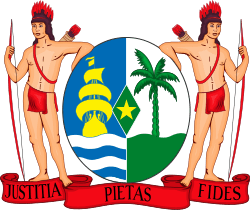Climate change in Suriname
Suriname is already seeing the effects of climate change, including warming temperatures and more extreme weather events. As a relatively poor country, its contributions to climate change have been limited; moreover, because of the large forest cover the country has been running a carbon-negative economy since 2014.[1]
Suriname was the second country to update its Nationally Determined Contributions in 2020.[2]
Emissions
Suriname has claimed a net-negative carbon economy since at least 2014.[1] This is in large part because of the dense forest cover over 93% of the country.[3] Most of the rainforest is still in pristine condition,[4] however it is being threatened by gold mining[5] and logging companies.[6]
Agriculture contributes 40% of the country's emissions.[2]
Petroleum industry
Petroleum exports are an important part of the economy of Suriname,[7] much of which is controlled by the state owned Staatsolie Maatschappij Suriname. As of January 2020, an American corporation, Apache Corporation, was drilling wells in Maka Central.[8]
Climate impacts
According to the World Bank, temperatures have already increased across the country, with a significant increase in hot weather.[9] Though precipitation has not shown any significant trend changes,[9] projections suggest significant changes in different parts of the country.[10]
The greatest risk Suriname faces is the flooding of the rivers. The population is concentrated around major rivers like the Suriname, Commewijne, and Marowijne River in an area a few meters above sea level.[11] In 2006 and 2015, there were majors floods even resulting in deaths.[12][13]
Moreover, 90% of Suriname's human activity is on the Northern coast, which is particularly vulnerable to sea level rise and salt water intrusion.[14][15]
Economic impacts
Agriculture
Though agriculture is a decreasing part of the total economy of the country, accounting for 9% of GDP in 2012, it is the third largest part of the Surinamese economy employing 15% of the population in 2009.[16] Changing weather and flood events are expect to have significant negative effects on agriculture in the country.[16] 49% of the economic losses of May 2006 floods in Suriname were agricultural.[16]
Policy
The Surinamese government was proactive about updating its Nationally Determined Contributions statement in 2020, second only behind the Climate change in the Marshall Islands.[1] The major commitments included maintenance of forests as a carbon sink, 35% renewable energy by 2030, and sustainable farming and transportation investments.[1]
References
- "Suriname's climate promise, for a sustainable future". UN News. 2020-01-31. Retrieved 2020-06-07.
- "Suriname's Second National Communication - In Progress | UNDP Climate Change Adaptation". www.adaptation-undp.org. Retrieved 2020-06-07.
- "Suriname's climate promise, for a sustainable future". UN News. 2020-01-31. Retrieved 2020-06-07.
- "Central Suriname Nature Reserve". Unesco. Retrieved 8 June 2020.
- "Een weg komt nooit alleen" (PDF). University of Amsterdam (in Dutch). Retrieved 8 June 2020.
- "Wanze Eduards and S. Hugo Jabini. Suriname Forests". Goldman Environmental Prize. Retrieved 8 June 2020.
- "Suriname | UNDP Climate Change Adaptation". www.adaptation-undp.org. Retrieved 2020-06-07.
- Blum, Jordan (2020-01-22). "Climate change also poses a threat to oil's exploration budgets, report finds". Houston Chronicle. Retrieved 2020-06-07.
- "Historical Climate Data Suriname". climateknowledgeportal.worldbank.org. Retrieved 2020-06-07.
- "Climate Data Projects Suriname". climateknowledgeportal.worldbank.org. Retrieved 2020-06-07.
- "Over 350,000 Surinamese to benefit from flood risk management". Prevention Web. Retrieved 9 June 2020.
- "'Doden als gevolg overstromingen Suriname'". nu.nl (in Dutch). Retrieved 8 June 2020.
- "Wateroverlast in Suriname door zware regen". Waterkant (in Dutch). Retrieved 8 June 2020.
- "Suriname's Second National Communication - In Progress | UNDP Climate Change Adaptation". www.adaptation-undp.org. Retrieved 2020-06-07.
- "Suriname's Second National Communication - In Progress | UNDP Climate Change Adaptation". www.adaptation-undp.org. Retrieved 2020-06-07.
- "Impacts on Agriculture". Climate Change Knowledge Portal. World Bank. Retrieved 2020-06-07.

.svg.png)